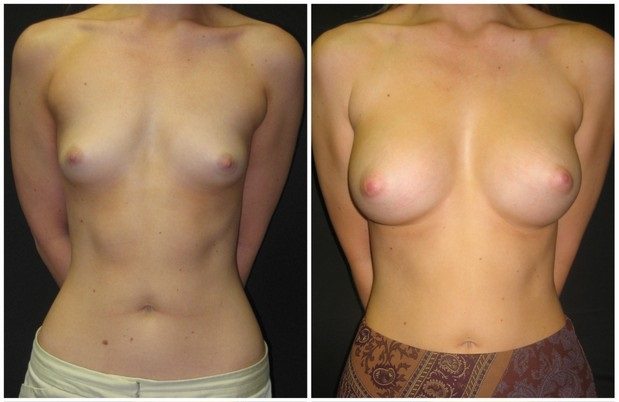Making the decision to undergo breast augmentation surgery is just the first step in the process. Along with deciding on the procedure, you’ll also need to decide how large you want your breasts to be and the type of implant you prefer.
Patients today have the choice between saline and silicone gel implants. Although both are considered safe and effective, some patients are better suited for silicone gel implants and some patients are better suited for saline implants. Understanding their differences empowers you to choose the best option for your unique needs and goals.
Understanding Saline Implants
Saline implants feature an outer shell that’s made of silicone rubber and are filled with sterile saltwater solution. This gives them a firmer feel compared to natural breast tissue and might be slightly noticeable under thin skin.
Benefits include:
- Lower initial cost compared to silicone implants.
- Easily detectable rupture: Rupture is evident due to deflation and a change in feel, allowing for prompt action.
- Safety: Considered safe and approved by regulatory agencies.
Considerations:
- Appearance: They may appear slightly rippled or visible under thin skin, especially in women with less tissue.
- Feel: They may not feel as natural as silicone implants due to their firmer texture.
The image below is a before and after a breast augmenation procedure using saline implants.

Understanding Silicone Implants
Silicone implants also feature an outer shell that’s made of silicone rubber but are filled with a silicone gel designed to mimic the feel and consistency of natural breast tissue. This results in a softer, more natural feel compared to saline implants. Their benefits include:
- Natural look and feel: Mimics the texture and appearance of natural breasts, offering a more aesthetically pleasing outcome.
- Reduced rippling: Less likely to show rippling or wrinkling under the skin.
- Customization: Available in various shapes and textures to cater to individual preferences and body types.
Considerations
- Higher initial cost compared to saline implants.
- Rupture detection: Rupture may not be immediately noticeable due to the gel’s consistency, requiring additional monitoring in some cases.
- Additional testing: Depending on your surgeon’s recommendations and individual circumstances, some patients may need optional MRIs to detect silent ruptures.
The image below is a before and after a breast augmenation procedure using silicone implants.

Silicone Safety Concerns
Silicone implants have a long history, and some of that history can make patients concerned. In the early 1990s, there was controversy and concern about the use of silicone implants.
Some patients claimed that their implants caused them a number of health problems, including auto-immune disorders. The panic was great enough that the FDA banned the use of silicone breast implants in 1992.
It wasn’t until 2006 that the FDA once again offered approval of silicone implants. Modern day silicone implants are more advanced than the implants on the market in the early 1990s. They are designed to be more durable and less likely to rupture. The gel used inside the implants is thicker, so that it is less likely to leak out if the implant is punctured.
Breast Implant Consultation and Decision Making
Choosing between saline and silicone implants involves careful consideration of several factors:
- Implant material: Understanding the pros and cons of both options, as discussed above.
- Desired size and aesthetics: Discussing your desired outcome with your surgeon to determine the optimal size and shape for your body and goals.
- Personal preferences and lifestyle: Considering factors like your comfort level with each material, desired level of adjustability, and budgetary constraints.
Along with choosing the implant material, your consultation with a plastic surgeon will also involve choosing the right size. You’ll be allowed to try on several different sizes, under your bra, until you find the size that you believe is best.
Dr. Bitar uses before and after breast augmentation photos to help patients decide on the appropriate size implant, too. In many cases, you’ll have two opportunities to try on implants, to make sure the size you pick is really the right one.
Post-Operative Adjustments
One potential difference between saline and silicone implants is the ability to adjust the size of the implant.
Post-operatively adjustable saline implants feature a small valve that can be accessed after surgery.
They allow a surgeon to adjust the volume of saline for a period of time after the initial procedure, meaning that if a patient isn’t happy with the size of her breasts, the surgeon can remove extra saline or add more after the initial surgery to decrease or increase the size as desired. A post-operatively adjustable saline implant needs to be selected before surgery as they differ from standard saline implants.
Silicone gel implants are pre-filled before insertion. If a patient isn’t happy with the size of her implants after surgery, her option is to have the first implants removed and replaced with a larger or smaller set.
Risk of Rupture
Both saline and silicone implants can rupture, but they manifest differently:
Saline Rupture:
One advantage of saline implants is that it is very obvious if the implant ruptures. The saline seeps out into the body where it is harmlessly absorbed, and the breast has a deflated look. Since saline is only saltwater, patients don’t have to worry about suffering any ill effects from having it leak.
Silicone Rupture:
Rupture and leaks were big concerns as far as older model silicone implants were concerned. It was once recommended that patients with silicone implants undergo an MRI every few years to make sure that the implants weren’t leaking.
If a silicone implant ruptures, it tends to be much less obvious than when a saline implant ruptures. The breast doesn’t deflate. Silicone leaking into the body is also more of a health concern than saline.
However, modern silicone gel implants are better made than older models and are more likely to last longer. While a patient with them can decide to undergo an MRI every three or so years, it’s typically not required or expected.
Breast Implant Durability and Replacement
The FDA stresses that neither silicone nor saline implants are meant to be lifetime devices. You might need to replace your implants after a period of years, either because they’ve worn out or because they are no longer the right fit for your body.
Frequently Asked Questions
Below are some questions from patients to help you understand saline vs. silicone implants. And make an informed decision about what is best for you
What is the most common type of breast implant?
Silicone implants are currently the most commonly chosen type of breast implant due to their more natural appearance and feel.
Which type of implant lasts longer?
Both saline and silicone implants can last for many years, but individual experiences may vary. Durability depends on various factors, including implant quality, surgical technique, and individual body characteristics.
Can I feel the implant through the skin?
The feelability of the implant depends on various factors, including implant size, your natural tissue amount, and the implant type. Saline implants might be more noticeable, especially in women with less tissue, while silicone implants generally feel softer and less detectable.
Do breast implants affect mammograms?
Yes, breast implants can make it more difficult.
Schedule a Consultation with an Experienced Plastic Surgeon
Choosing the right implant type is an essential step in your breast augmentation journey. By understanding the characteristics of saline and silicone implants, engaging in open communication with your board certified, experienced surgeon, and carefully considering your individual needs and preferences, you can make an informed and personalized decision to achieve your desired outcome.
To learn more about your implant options, contact Dr. George Bitar. Dr. Bitar is proud to serve patients from all over Northern Virginia and Washington, D.C., and Maryland area. His reputation as a leading plastic surgeon has attracted patients from all over the region. Call the office at (703) 206-0506 or schedule an appointment online today.

George Bitar, MD, FACS is an award-winning, board-certified cosmetic and reconstructive plastic surgeon, the Founder and Medical Director of Bitar Cosmetic Surgery Institute in Virginia. He specializes in the latest surgical and minimally invasive techniques to scar management and reduction. Dr. Bitar is involved in groundbreaking research and education in plastic surgery and has authored numerous articles, abstracts, and chapters.





